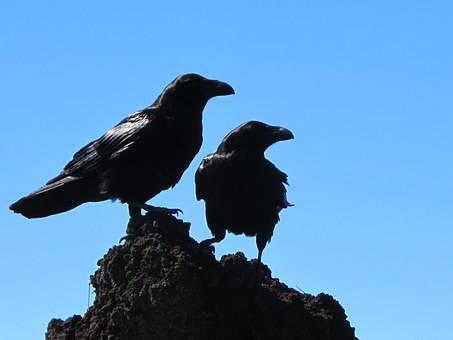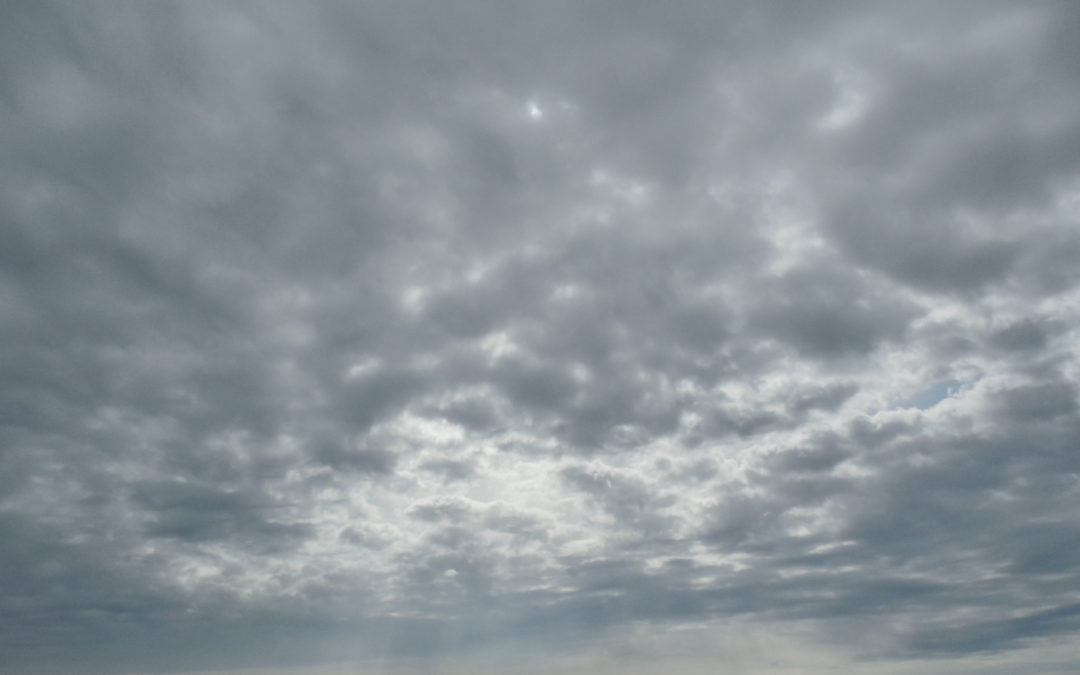
by LibbyAtwater | Jul 10, 2017 | Blog
I peered into our once-thriving orchard that bore fewer avocado trues since the drought began. There I spotted a black object lying in the dirt. At first I thought a plastic trash bag had been tossed over the fence. As I moved closer, I realized that this was not a trash bag but an animal’s carcass. Could it be a neighbor’s cat? It looked too large.
I opened the orchard gate, descending the railroad-tie steps down the steep slope unsure of what I’d find. When I reached the bottom, I waded through the piles of dead leaves and discovered a second black object—the body of a crow. I climbed the hill to where the first carcass lay and realized it was another crow. I could not tell what killed them until I saw punctures on one’s neck and its empty eye sockets.
Poor Heckle and Jeckle, I thought. Yes, they were annoying, but they certainly did not deserve to be killed and left. The sight of them lying there dead upset me. I walked back to the house and told Don what I found.
“Hawks are bird of prey,” he noted. “Sometimes they hunt to eat and other times they just kill.”
Shortly afterwards, our gardening team arrived for weekly maintenance. When you live on an acre of land, you need help. I told them about my discovery, and the gardener’s son stepped forward and said, “I’ll help you bury them. Let me get my shovel.”
Until that morning, I’d never been particularly impressed with this young man. He did not seem to enjoy his work, and I suspected he had been forced into his profession by his parents, who worked alongside him. Together, we went down to the orchard. “Yup, it was definitely a hawk,” he said. “Look at the marks on their necks.” Then he dug two deep holes in the corner of the orchard, and we chatted about his weekend and various things while he labored away. Finally, he carefully lifted each bird into its respective grave. As he covered the graves with dirt, he said, “God be with you,” while I silently said a prayer. That morning I gained new respect for this young man.
Yet I still felt the crows’ deaths were a bad omen, and the thought gnawed at me all day. Finally, I searched for “symbolism of dead crows” on my computer. To my surprise, two answers came up. Dead crows can be messengers of death or messengers of change. I’d experienced enough death, especially during the month of May, to hope for the latter. I chose messengers of change as the meaning I would embrace.
I spent the entire day writing for the first time in months. It felt great to be doing what I loved most after a long hiatus. Perhaps these deaths, as the deaths of many loved ones, had been my inspiration.
Years ago when Don and I ventured to Africa, our tour guide identified the animals we’d see. Then she stated the monikers that defined a group of each particular animal and gave us a list. For example, we saw a pride of lions, a zeal of zebras, a parade of elephants, a thunder of hippopotami, a leap of leopards, a troop of baboons, a tower of giraffes, a cackle of hyenas, and a pot of water buffaloes. But we never saw a murder of crows.
I found one in my own back yard.

by LibbyAtwater | Jun 14, 2017 | Blog
Memorial Day weekend brought two huge crows with their cacophonous cackling to our yard. They’d visited before, but this weekend they remained close to our home, alighting on a nearby utility pole constantly calling to each other. Their noise grew annoying as we worked in the yard, and I wished they would be quiet.
Later that day I discovered them in our bird bath located at the top of our avocado orchard. One sat on the chain link fence looking soaked while the other sat in the bird bath dipping its food into the water.
“Don, look at these crows in the bird bath. I think Heckle and Jeckle (two cartoon crows from our childhoods) have arrived,” I said to my husband.
“It looks that way,” he said. “They seem to have taken over and scared the smaller birds away.”
Living in the hills of Southern California, I viewed the crows as representatives of the diverse wildlife that calls our neighborhood home. We’ve seen a bobcat, a mountain lion, coyotes, roadrunners, skunks, rabbits, lizards, a variety of birds, hawks, rats, mice, and a number of different snakes. When you live on the edge of wilderness, you learn to coexist with its first inhabitants.
Despite this knowledge, I was startled when I spotted a huge red-tailed hawk swooping over our orchard as I opened the window shade a few days later. I had never seen a hawk so close to our home. I stood at the window transfixed by its aerial aerobics and said, “Don, look at this hawk. It’s magnificent.”
My husband ran into the room to see the large raptor repeatedly circle our property. “That’s unusual,” he remarked. “We don’t often see hawks in the morning and rarely this close to the yard. It’s hunting.”
We both thought nature had given us a great show to start our day and never thought about its prey.
The next morning I discovered the hawk’s true mission. When I made my morning outside rounds of the yard, I peered into our once-thriving orchard that bore fewer avocado trees since the drought began. There I spotted a black object lying in the dirt. At first I thought a plastic trash bag had been tossed over the fence. As I moved closer, I realized that this was not a trash bag but an animal’s carcass. Could it be a neighbor’s cat? It looked too large.
I opened the gate, descending the railroad-tie steps down the orchard’s steep slope unsure of what I’d find. (to be continued)

by LibbyAtwater | May 26, 2017 | Memories
Excerpt from the Multiple Award-Winning Memoir, “What Lies Within”
I arrived in California on Memorial Day weekend 1961. Expecting sunshine and flowers, I encountered moisture-laden gray skies and barren desert. “Where’s the sun?” I asked my uncle, who had driven my mother, sister, and me across country. “You told us we were going to sunny Southern California.”
“We don’t get much sun this time of year,” Uncle Richard replied. “If it comes out at all, the sun will appear late in the afternoon.”
My expectations fell once more. I had not wanted to leave New Jersey and suspected the gray skies portended things to come. While I’d experienced many gray days growing up back East, I thought California would be different and return the sunshine to our newly changed lives.
Unc tried to lift my spirits by taking me to the beach the next day. We drove from Alhambra to Redondo Beach, where I saw the Pacific Ocean for the first time. The sun shone on the inviting azure-toned water, so different from the leaden-looking Atlantic. We strolled down to the beach to get a closer look. Teenagers resembling models in sun tan lotion ads strolled along the shore.
I just stared, feeling like an awkward, pale-skinned, dishwater blond from New Jersey amidst the bronzed, bikini-clad California girls and the guys who hung all over them. They all looked so tan and confident.
“Let’s go,” I pleaded. “I don’t feel like swimming today.”
Bewildered, my uncle drove back to Alhambra, wondering what had happened to transform the sunny day to May gray.
by LibbyAtwater | Apr 3, 2017 | Blog
Our wonderful trip to South America for three weeks in February became more of an adventure than we anticipated.
Our first glimpse of the majestic Andes came from 40,000 feet as the sun rose over Peru. What a magnificent spectacle as we soared through the clouds! These imposing mountains became omnipresent throughout our stay in Chile, forming a backdrop for our sightseeing and an imposing physical barrier between Chile and Argentina.
While on a three-week cruise from Santiago to Buenos Aires, we explored cities, towns, nature reserves, and national parks that showcased the cultures of Chile, Argentina, the Falkland Islands (Las Malvinas for our Argentinian friends), and Uruguay. The scenery was pristine, and meeting the people and learning about the cultures was enlightening.
On our journey we met lovely, interesting people from all over the world: Great Britain, Austria, Germany, Switzerland, Denmark, Australia, Canada, and a number of other countries. Many planned to stay on board for nine weeks, as they sailed from and back to Florida. We discovered that seventeen days aboard a ship fulfilled our need to be at sea.
We returned home tired but excited about the places we’d seen and the people we met. Two days after our return, my husband and I became very ill. Five days later we spent the day in our local hospital’s ER receiving IV fluids and being diagnosed with E. coli. We have since recovered from the initial bout, but we tire easily and require more rest than usual.
And that, my friends, is why I have not posted or written my blog since prior to my departure.
This illness made me realize how fragile life is and how we must treasure every moment.
Wishing you all good health and lives filled with small treasures.

by LibbyAtwater | Jan 11, 2017 | Author Expertise, Blog, Memoirs, The Spirit of Villarosa, What Lies Within
The new year is already ten days old, but I still wish people a Happy New Year when I encounter them. Starting the new year with positive wishes seems only right.
(more…)




